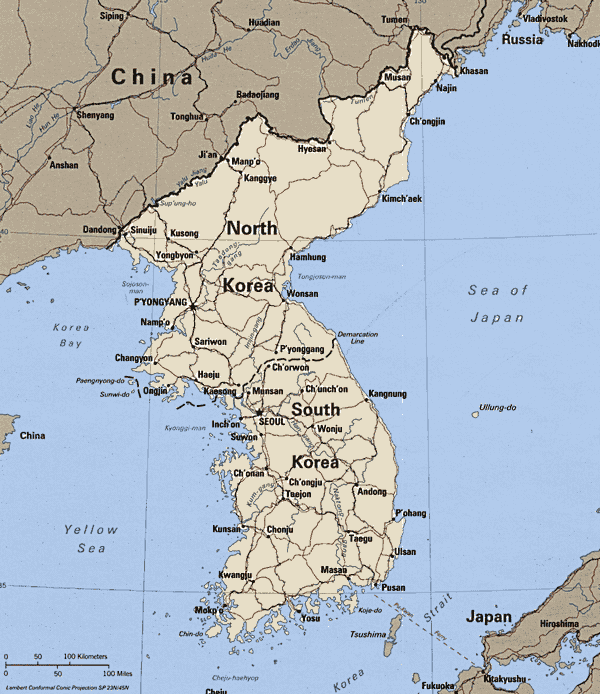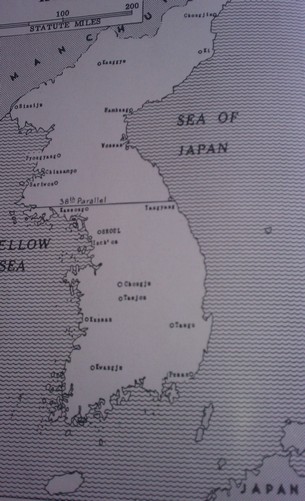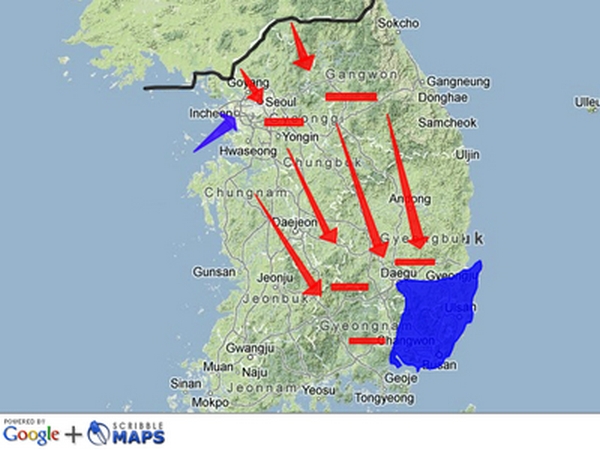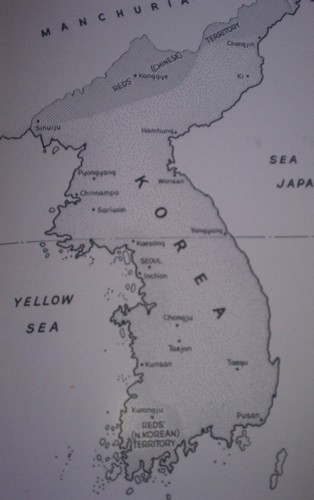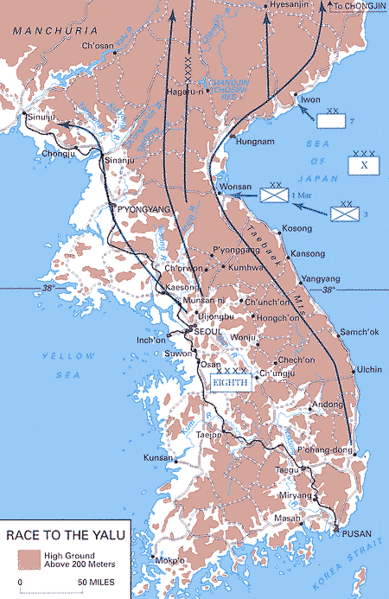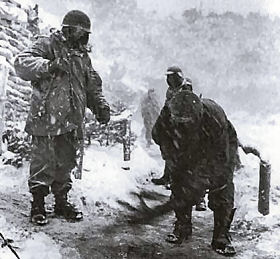Korean War Facts
1950-1953
The world had hoped that the United Nations would insure peace. Five years after World War 2, Korea would shatter that Illusion. Soviet leaders looked for regions where communism would find fertile conditions. Wherever they "liberated" a country, or became its "trustee", the Russian leaders interpreted their mandates to mean annexation or domination. This policy would apply to Korea. Soviet Russia found it was in their Cold War interests to engage the United States, through its surrogates, in a hot war. Later leaders may have had some regrets.
When the Japanese surrendered in 1945, Soviet Russia accepted the surrender of their armed forces in the north of Korea, and the United States accepted it in the south. As trustees they pledged an early, democratic election aimed at unification of the peninsula. Promises to that effect were affirmed in the 1945 Potsdam Declaration and reaffirmed by the Soviets when it belatedly declared war against Japan in August 1945. Their late entry apparently was calculated to insert their influence in Asia. In Ocober 1945, Soviet soldiers began their occupation of North Korea.
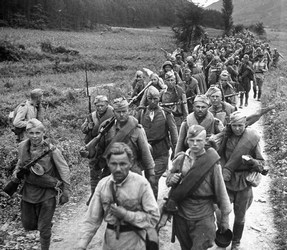
The Korean peninsular is 625 miles long and was home to about 30 million culturally and linguistically homogenous peoples. Communist ideology directed from Moscow aimed to divide these people by asserting total control over North Korea. Even Korean weather was controlled by Russia's Siberian winds that were destined to add to the hardships suffered by United Nations soldiers in 1950.
Korean War Facts click to enlarge
The Potsdam agreement had established the 38th parallel as a temporary line of demarcation to effect an orderly administration after the Japanese surrender. The agreement specifically stated that partition was effected "provisionally". Soviet Russia and the United States were appointed trustees with the mandate to supervise democratic elections that would unify Korea.
Korean War Facts Japanese soldier surrenders sidearm to GI of 7th Division.
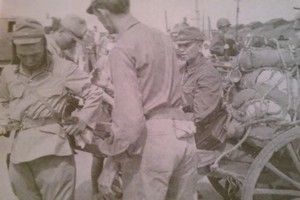
The Soviet military occupied North Korea upon Japanese surrender. In short order, the 38th parallel became an extension of the Soviet's "iron curtain". This descriptive metaphor was supplied by Winston Churchill in 1946 when he described Soviet Russia's cold war strategy in Europe that now extended to Asia. The iron curtain formula meant the installation of a police state, exclusion of western, democratic influence and was instantly established in North Korea. This policy denied any United Nations participation and effectively sealed the north from world scrutiny.
Korean War Facts Soviet soldiers in Son Do Kaijo, North Korea.
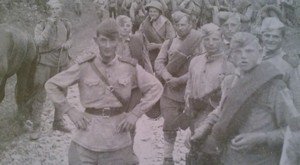
Although three quarters of Korea's natural
resources were in the north ,and potentially a much stronger economy
than the south, the geographical benefits were diverted by the costs
of militarization.
In the south, the United Nations oversaw a democratic election on May 10, 1948. The Republic of Korea (ROK) was created and its popularly elected a National Assembly chose the country's first president, Syngman Rhee. His government remained in power from 1948-1961, and a fair assessment of Rhee is to to describe his governing style as authoritarian.
Korean War Facts Capitol Building Seoul, South Korea
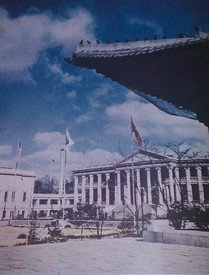
n August 1948, a communist type election was held in the north with
candidates chosen by the Communist North Korean People's Committee. The
totalitarian regime was led by Kim Il - Sung pledging to unify north and
south under communist rule. Soviet aid would diminish over time as the
North slowly shifted allegiance to the communist rulers in China because of proximity and
the Chinese doctrinaire belief in the Marxist-Leninist philosophy. He carried totalitarianism to new heights as a cult figure that bordered on the Godly.
On December 12, 1948,
the United Nations General Assembly called on the occupying powers to
withdraw, and the United States removed its troops on June 19, 1949.
The General Assembly went a step further and declared that South Korea
was the only lawful government in Korea.The Soviet Union did not comply.
The
38th parallel, the "temporary" international border, became a hard
line. It created a no-mans land over two miles deep. That invisible
line and its surrounding, forbidden area was then subjected to many armed
raids and incursions directed as a matter of policy by the new Soviet
satellite government. Army guards were permanently maintained on both
sides of the line to protect the integrity of the boundary, but the ROK
security forces were in constant danger from the military probes
provoked by the north. The term, "demilitarized zone" became a misnomer.
Korean War Facts Korean War Facts
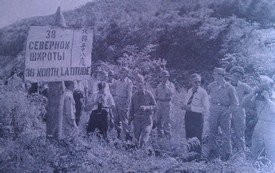 |
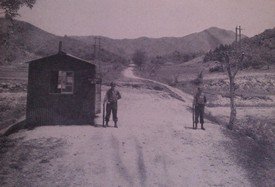 |
1950
Korean War Facts click to enlarge
A belated review of the intelligence revealed that prior to the attack there was evidence of a significant build up of the communist forces. Their forces, unlike the South, were formed for an offensive war. The Northern infantry was augmented by 25,000 battle hardened veterans that had served in Manchuria alongside Chinese troops in 1945.
The North Koreans used a familiar strategy employed by the Axis countries only a few years before. Their sneak attack repeated the Japanese attack on Pearl Harbor. In addition, they took a page from the Nazi propaganda playbook that claimed the Polish had initiated an attack on the Germans in the Gleiwitz radio incident in 1939. On the same morning they crossed the 38th line, Pyongyang radio broadcasted that their forces were engaged in repulsing a wanton attack started by the South.
An emergency session of the United Nations met in New York. Soviet Russia boycotted the meeting because the United nations had refused a seat to the newly formed Peoples Republic of China. Absent their veto power, the United Nations Security Council received testimony from its Commission on Korea, reporting the invasion, and voted to send a force to oppose the North Korean aggression. On July 7, The U.N. established a single command and President Truman appointed General Douglas MacArthur the commander of the multi national force. The United States contributed 88% to its composition. By August, forty -eight member nations would ultimately contribute troops or material aid to the U.N. effort.
President Harry S. Truman, immediately upon the report of the invasion, ordered the deployment of Americans to Korea. He did not seek congressional approval, a constitutional requirement for a declaration of war, as the U.N. had deemed their participation a "police action". This fine distinction went largely unchallenged.
The west coast of the United States served as embarkation points for the GIs as well as Japanese ports where Americans were stationed. The southern tip of Korea was only 70 miles from the nearest Japanese home island.
U.S. airstrikes began on June 28. They bombed targets in North Korea in an effort to cut supplies and communications. The planes were a mix of jet and propeller operated. The first small contingent of Americans arrived on July 1. Their immediate duty, with the aid of arriving Australians, was to delay the advance of the North. General MacArthur, in his initial report to the United Nations, stated that his forces were often outnumbered 20 to 1. He further reported that U.S. Naval operations had successfully created a blockade of the entire coast and destroyed a third of the enemy navy.
On June 28, the south Korean capital, Seoul, fell to the North Korean's. Seoul would remain a target of the north and the locale for five full scale battles.
Korean War Facts
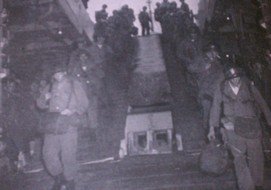 |
 |
On the ground, the weight of numbers gradually pushed U.N. forces back. The GIs reported a problem in distinguishing the good guys from the bad. North Koreans infiltrated behind the U.N. lines and blended with the southern population. (The first American Korean war movie, "The Steel Helmet" released in 1951, also left the audience befuddled. They also were unable to distinguish the North Koreans from their Southern counterparts.)
The earliest contingents of Americans and the British Commonwealth countries were not fully equipped on the ground . They were essentially a peace time army with occupation duties that did not require wartime materiel. The necessary ordnance and armor would be forthcoming, but required build up, assembly and shipping over thousands of miles of ocean. Over the course of the war, almost 1.8 million Americans would see service on the Korean peninsula.
By mid July, American planes controlled the air space. Lessons learned in World War 2, particularly the use of fighters for strafing, were stalling, but not stopping, North Korean advances on the ground who were taking heavy casualties. Many North Koreans were surrendering and were being held under the rules of the Geneva Convention which required humane treatment. However, evidence of North Korean atrocities were surfacing.
Korean War Facts On the left, a north Korean surrender. On the right, one of four Americans found bound and executed.
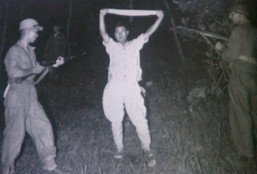 |
 |
On August 15, 41 Americans of the 1st Cavalry Division were captured. They were bound with telephone wire with hands tied behind their backs. They were stood up and shot down on August 17. Five GIs were able to escape back to American lines.
By September, 4,000 North Korean prisoners were in custody and receiving humane treatment.
The North Korean forces were not advancing in a unified line. They were moving southward in 4 separate areas. Their pace and probes were uneven. Their power was divided, east from west, by the central mountains that divides the south. It was clear to MacArthur that the enemy on the east coast was heading to the southern port of Pusan, a central location for debarking reinforcements and materiel for the U.N. effort. Korean War Facts
Korean War Facts Click to enlarge
Pusan also served the important purpose of evacuating U.N. wounded to nearby Japan. In the effort to protect Pusan, air strikes from U.S. carriers were ramped up. In addition to the bombing runs over the north, the fighters effectively furnished close air to ground support. Planes, also launched from Japan, harassed the enemy so extensively that North Koreans limited their movements almost entirely to the night. This strategy did not appreciably affect the air campaign. By September 15, 28,000 combat missions were flown with loss of 100 planes.
Korean War Facts Bombed Pyongyang , N. Korea Capital
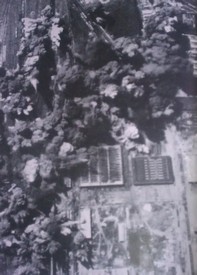
ROK forces had stiffened their ability to slow the enemy advances as part of the overall strategy to buy time awaiting incoming reinforcements and material aid. As the first month of war was passed, General MacArthur, reported to the U.N.
"Army operations were, basically, planned withdrawals and delaying actions to gain time".
In August, the ROK forces were placed under the control of the U.N. command. There were evident problems with language barriers. The lingua - franca was English and the number of translators on the ground were rapidly increased. The South Koreans were demoralized after the first two weeks of the war. Their losses in those early weeks were high. However, they had recovered to the point that their gradual withdrawals and participation in the U.N.s delaying actions were effective. They were buoyed by the increasing number of nations joining their cause:
Australia, Canada, France, Holland, Belgium, England, New Zealand, India, Turkey, Greece, Luxembourg, Ethiopia, Colombia, Italy joined the coalition in 1951.
The U.N. forces in the southeast were cornered in the Pusan region (see map above). In a minor counter-offensive on August 7 led by the 25th Division, a marine brigade and ROK battalion was begun to gain a stronger defense line to protect Pusan. In a week's time they extended their line by 20 miles. This limited campaign established that the North Korean soldiers were not super men and would fold under a sustained attack. The import of their hasty retreat, however, was minimized by their overall numerical superiority.
Each small U.N.
victory followed the same pattern. In early August, two ROK Corps
recaptured the eastern town of Yongdok. In three days, northern forces
had rebuilt their division and retook the town. Korean War Facts Artillery spotter 1st Cavalry Division
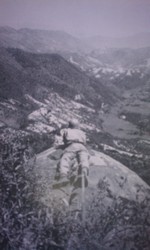
Just south of Seoul. the Inchon peninsula is located on the west coast. On September 15, General Mac Arthur's troops completed an amphibious landing in Inchon Harbor.The 5th Marine Division completely surprised the North Koreans and in two hours secured the beachhead. They cleared Kimpo airfield, the largest in the country, and made it available for the U.N. air force. Korean War Facts
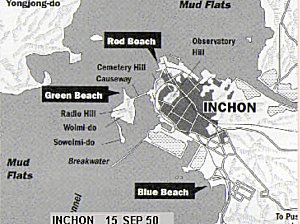
In the first
4 days, the 1st Marine Division and two ROK battalions marched north and crossed
the Han River. The target was Seoul and the North Korean bastion on
South Mountain. All the ground activity was confined to the south, but that would change.
Three months after its fall, Seoul and South Mountain were recaptured. Not only was this significant in terms of morale for U.N. troops, it smashed the supply and communication system that North Korea had set up in the south's capital. In a matter of days, the Korean capital was again the seat of their government. The defense of the city by the North Koreans was called "fanatic". Korean War Facts
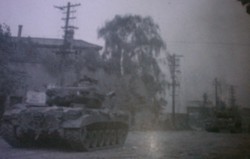 |
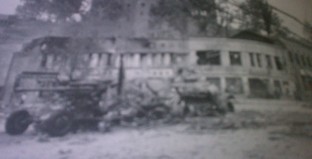 |
In a coordinated move on the opposite east coast, the encircled 8th Army (U.S., British, Australian and Philippine units) in the Pusan region began a counter offensive pushing northward. They were able to retake the port of Pohang-dong. At the same time, a U.N. force was advancing against a large pocket of northern forces in the southwest and trapping them. As September ended. the successful offensives and pincer movements had broken the North Korean army. The U.N. forces were comprised of 8 countries integrated into a large naval group, ground forces of 5 nations and 2 nations formed the air force. Before years end, naval units from Thailand joined the U.N. Navy. Pusan Korean War Facts

The U.N. forces were scoring victories on the ground and controlled air and sea.The feeling was euphoric. The U.N. was in control of South Korea to the 38th parallel although thousands of northern troops were still cut off in the south. On October 9, The U.N. troops crossed the 38th parallel at Kaesong. By mid October, over 66.000 North Korean soldiers were prisoners of war. Korean War Facts
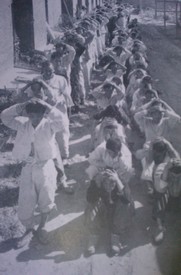
In a surprise to Americans, on October 15, President Truman met with General MacArthur on Wake Island. The president adamantly pressed MacArthur to avoid bringing the Chinese into the conflict. The general assured the president that the Chinese would not cross into North Korea. This concern about Chinese intervention was a lesson learned by President Johnson years later in leading Americans in Vietnam. Korean War Facts
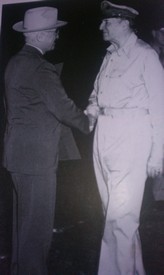
During October, U.N. forces were fully committed to offensive actions north of the 38th parallel. Movement of ROK infantry was augmented by paratroopers threatening the North's capital at Pyongyang and amphibious Marine landings near Wonson on the opposite coast. Naval operations in the Wonson area was directed at a huge mine sweeping operation.These areas were secured by the United Nations forces that were augmented by the arrival of Turkish troops that were attached to the 8th Army.
The refugee problem that had beset civilians in the south was now repeated in the north. Food and shelter were in short supply.
click to enlarge
November saw a significant change in weather and action on the ground. United Nations forces had advanced to North Korea's northern border with China at the Yalu River. Initially, U.N. military observed a stiffening of resistance by the North Koreans. What appeared, at first, as some Chinese volunteers in Korean uniforms suddenly became entire Chinese divisions that crossed over the frozen Yalu River. ROK forces were overrun and U.S. Marines were trapped in the Chosin Reservoir area. Masses of Chinese troops attacked the dug in and outnumbered Americans in suicidal waves.Whole enemy battalions were armed with only grenades. Other battalions were heavily armed with Soviet burp guns that were both semi and automatic assault weapons, They were matched by the American BAR's. .American casualties were high, but the Chinese, without regard for their losses, were far greater.Truman suggested. in retrospect, that he was contemplating using the atom bomb.
Korean War Facts click to enlarge
Russian MG-15 fighters piloted by Chinese appeared in the sky over North Korea. The Truman prohibition about crossing the Chinese frontier applied to the air war. MacArthur expressed his frustration with that policy that prevented hot pursuit.
"The superiority of United Nations pilots was nullified upon occasion when hard-pressed Communist fliers utilized the border to break off combat and improve their tactical position by gaining altitude, or by other maneuvers, and then returned to combat".
It is safe to say that, by December, the United Nations Army was exclusively confronting Chinese divisions. The North Korean army was no longer a factor in their own country. What had been a U.N. victory march through North Korea was now a fighting retreat south. However, the retreat was not a rout and U.N. armies were able to take with them much of the heavy military equipment and not leave it to the enemy. Some of the armored vehicles and tanks were jettisoned over cliffs or in other ways destroyed. The evacuation ultimately led to a North Korean port and rescue by naval units. The similarity with Dunkirk in World War 2 is striking with the exception that the U.N. forces were ushered to safety by a much stronger protective ring.
As the year closed, President Truman declared a state of national emergency. .
The 1st Marine Division moving south in zero degree weather with air cover and the heavy guns stationed off shore. Korean War Facts
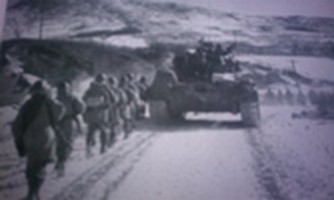 Americans evacuated. |
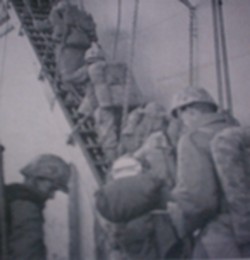 |
1951
The 38th boundary line was quickly breached by the Chinese troops. Seoul was again under communist control, but when it was recaptured by the U.N. in March, the term "stalemate" began to find common currency. The quagmire deepened when the Chinese Peoples Volunteer Army unsuccessfully attempted to retake Seoul in April.
In the United States, stock prices tumbled and commodity prices went through the roof. Conscription was instituted and a call on young men to serve. Price controls were put in place on food and war sensitive materials.
General MacArthur, who prematurely promised that "the boys will be home for Christmas", was now lobbying Washington for the right to make strikes against China. President Truman feared extending the war would be an invitation for the Soviet Union to join the war. An intercepted cable from Joseph Stalin to his Chinese counterpart, Mao, indicated that "a long and drawn out war in Korea" would be the best outcome. The Chinese would soon realize that this strategy was draining Chinese lives and not Russians. In addition to the U.N. forces adding to Chinese casualties, frost bite and typhus were taking their toll.In areas under U.N. control, there was a DDT spraying program, and vaccinations against typhus for the civilians. Korean War Facts
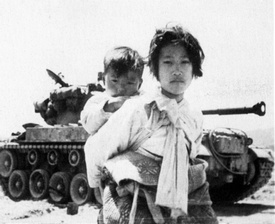
MacArthur sought permission to bomb Chinese cities. He even sought the use of atomic bombs. His challenges to Truman were in the public domain. The president, on April 11, as commander-in-chief, relieved MacArthur of his command. He was replaced by General Matthew Ridgway who was already on the ground as commander of the 8th Army. He had already been forced to withdraw his men from Seoul and Inchon (January 4)
In July, the first of numerous peace talks was held at Kaesong----close to the 38th parallel. Korean War Facts

In September, an American and French contingent engaged in a battle that stretched over 3 weeks. The U.N. held hill 931 (Heartbreak Ridge) but suffered over 3000 casualties. The Chinese and North Koreans reportedly had losses of over 25,000. The U.N. command began to understand that this type of battle for inconsequential land just north of the 38th was not worth the casualties. Despite this point of view, there would be other similar battles. Korean War Facts
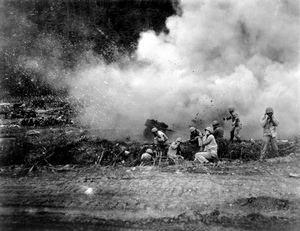
The U.N. counter-offensives had already begun in March (Operation Ripper) under the leadership of Ridgway. By May, the Chinese were ceding most of their gains and in June lost Pyongyang just north of the 38th boundary line. The belligerents were ready for peace talks. This unproductive meeting was the first of many. On November 28, there was another meeting at which time the Chinese submitted a list of 3100 prisoners of war without an accounting for 50,000 other missing men.This was a source of dispute with the Chinese who sought involuntary repatriation of all their nationals as well as North Korean troops. President Truman called that position “repugnant to moral principles” and insisted that negotiators recognize this principle.
Each truce period provided the Chinese an opportunity to rebuild their forces.
1952
As the war stretched into the third year, Stalin was getting his wish. His cold war with the west was reaping the benefits of using surrogates to stretch resources of his enemies.
In April. a
threat of a steel strike Truman believed would affect the war effort.
He seized Youngstown Sheet and Tube. Later his seizure was declared unconstitutional by
the Supreme Court.
Most of the engagements were around the 38th parallel. However, in June, the U.S. Air Force was active. They bombed North Korean power plants at the Yalu River. The proximity to Chinese territory alarmed a number of U.N. allies.
Although the first half of the year involved inconclusive skirmishes and battles, the casualties on both sides were mounting. The fall was devoted to the latest round of peace talks. On October 8, the talks were suspended indefinitely. Korean War Facts
Casualties 7th U.S. Infantry Division
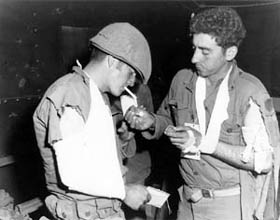
General Eisenhower was elected President of the United States and had vowed to go to Korea, if elected, to bring an end to the war. In December, Eisenhower traveled to Korea and reviewed the battle plans. He also attempted to convince President Rhee to be more flexible in peace negotiations. He was not successful. Rhee had won another rigged election and felt quite secure.
The stalemate continued. The year involved small unit skirmishes and was a harbinger of 1953. There were a few exceptions.
1953
March 5, 1953: the most momentous day of the Korean war. Joseph Stalin died and so did the war. His death lifted the pressure on the Chinese to continue the war. It allowed them greater flexibility in negotiations with the U.N. They had suffered huge casualties with little upside for their internal politics and geopolitical position.
On the other side of the table, Dr. Rhee, President of the Republic of Korea was adamantly opposed to the peace negotiations. His aim for a greater Korea was at odds with the U.N. target to protect the prewar border of South Korea. Rhee refused to take a seat at this last armistice talks, but would ultimately ratify its results for an undefined limited time. The mutual defense pact offered to the south in August appears to have mollified Rhee's resistance. Korean War Facts
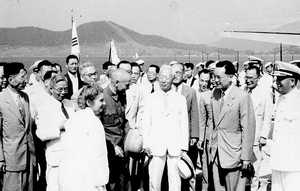
Although it was becoming increasingly known that an armistice would be effected, the belligerents were pressing to hold territory that would assist their negotiating positions. Two such positions were held by the U.N. north of the 38th line. Both sites had no practical tactical significance. Unfortunately, the U.N. command failed to note this distinction.
On March 23, Chinese seized several ridges, including "Old Baldy", near hill 255 which the American's called Pork chop Hill. A company of the 7th Division was subject to a heavy bombardment on the night of April 16 and followed by an all out attack to dislodge the Americans. Over a 2 day period control fluctuated. However, the Americans were reinforced on April 18, and with aid of the new company, cleared the hill of Chinese bunkers and trenches.
The Chinese command still maintained the hill in its sights. Commencing on July 6, a week long battle for the hill's control was fought in a raging monsoon. On the first day, the U.N. withdrew. On the next day, with reinforcements, they retook the hill. This scenario was repeated until July 10, when elements of the 7th Division withdrew and the Chinese had another hill. Result: 243 American deaths and estimated 1500 Chinese died. Korean War Facts

On the eve of an impending armistice, there were Americans performing acts of heroism and earning the Distinguished Unit Citation.
"No.56 Washington 25, D.C.20 July 1954. "the following unit is cited under AR 220-315 in the name of the President of the United States as public evidence of deserved honor and distinction. The citation reads as follows:
The 140th Tank Battalion, 40th Infantry Division, is cited for outstanding performance of duty and extraordinary heroism in action against the enemy in the vicinity of Nojonp-Yong, Korea, during the period 1 to 8 June and 16 to 18 July 1953. Committed to the direct support of the 12th Republic of Korea Army Division, the battalion had been manning tank positions on four vitally strategic Hills. On the night of 1 June the enemy began preparatory fire followed by a large scale attack on one of the hills and succeeded in displacing infantry elements. However, the tank platoon located in that sector refused to leave its positions and continued valiant efforts in denying the enemy its objective. That night another platoon moved up under the supporting fires of Company B and Company C to aid the beleaguered unit, and the following morning they were reinforced by an addition(al) platoon. Fierce action continued through out the remainder of 2 June with the tankers resolutely refusing to withdraw. With tanks spearheading the infantry, a counterattack was launched on the morning of 3 June and although it did not clear the hill it permitted the besieged tanks to be replaced with others which, supported by the balance of battalion tanks, denied the enemy access to the crest. On 5 June . Company A, which was in reserve 56 miles to the rear, was altered and moved in an excellently coordinated forced march and arrived in an exceedingly short time to relieve Company B. That evening the hostile force began concentrated attacks on two adjacent hills and gained a few friendly posts, however, the infantry inspired by the tankers' valiant stand, counterattacked and hurled the enemy from these positions. In the remaining days from 6 to 8 June the battalion continued devastating fire against hostile positions, sealing off approach routes and permitting friendly lined to be reconsolidated. Fierce as these actions were, it was realized that they were but a prelude to a more massive attack to seize the entire hill complex and clear the way to the south. On the night of 16 July, the foe commenced battalion sized attacks against two of the hill positions. The combined tank, artillery, and infantry fires, particularly flanking fire from the tanks which the aggressor had not anticipated, destroyed one battalion and so decimated the others that it only made minor gains. The following night small diversionary actions were attempted and on the morning of 18 July they began a regimental size attack against another sector. Here the aggressiveness, esprit de corps. and prowess of the defenders succeeded in wreaking havoc among the hostile force. The superb gallantry of the tankers displayed in both phases of this action paved the way for a stiffened defense and better coordination and as a result the attacking enemy was completely demoralized and ceased to be an affective striking force. The heroism and courage exhibited by the members of this unit in denying the enemy a vitally strategic area reflect great credit on themselves, their organization and the military service of the United States. (General Orders 285, Headquarters Eight United States Army, 10 may 1954.)"
Contributed by Sergeant First Class, Sid Shane, Ret.
On the heels of Pork Chop Hill, British U.N. contingents and Americans held a salient north of the boundary line in enemy territory. They occupied a ridge, hill 111, shaped as a crescent and was called the "hook". They were warned of an impending attack when they were subjected to a heavy artillery attack over 2 days. July 19 and 20.
The attack began on July 24 by the Chinese which were repulsed by Australians manning heavy machine guns. On the next night, the Chinese mounted a second attack. With the aid of U.N. artillery, they were repulsed. Thus ended the United Nations."police action."
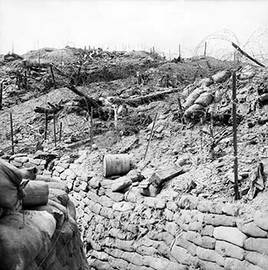
Within 3 days from the last battle (July 27), the war ended with an armistice agreement. Prisoners were given the option regarding repatriation. the 38th parallel was reconfirmed. A future peace conference is still in the world's future. General Mark Clark signed the agreement on behalf of the United Nations. Korean War Facts
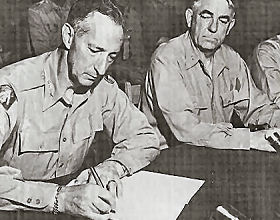
In our initial analysis of the timeline, we indicated that the parties, by the terms of the armistice, were restored to their pre-war geographical positions. Essentially a stand-off? Not quite. The reader will recall that the intent of North Korean aggression was to unite north and south under the communist banner. The United States/U.N. intervention prevented that goal. It also produced a country in the north with one of the most repressive governments in the world-----to the detriment of their citizens and a threat to future world peace. The cost in American lives, almost 37,000 men.
___________________________________________________________________
Korean War Facts
See Korean War Memorial
See Korean War Photos
References and Sources:
American Decades 1950-1959. Editor: Richard Layman. Gale Research Inc.Detroit, Mi 1994.
Asia in Focus The Koreas. Editor: Mary E. Connor. ABC Clio, Santa Barbara, 2009.
Breen, Michael. The Koreans . St. Martins Press. New York 1998
Catchpole, Brian. The Korean War. Carroll & Graf New York 1998.
Jager, Sheila Miyoshi. Brothers at War. W.W. Norton & Company, New York 2013.
General Douglas MacArthur. Reports to the United Nations.
Schwartz, Rihard A. The 1950s. Facts on File, Inc. New York 2005.
The Fifties in America. Editor: John C. Super. Salem Press, Inc. Pasadena, Ca 2005.
American War History | Korean War Timeline | Korean War Facts
